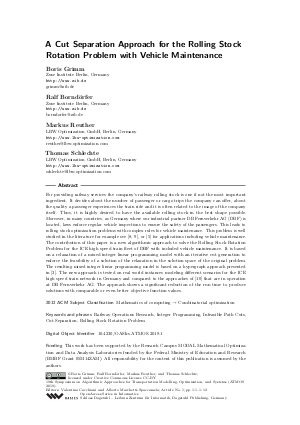A Cut Separation Approach for the Rolling Stock Rotation Problem with Vehicle Maintenance
Authors Boris Grimm, Ralf Borndörfer, Markus Reuther, Thomas Schlechte
-
Part of:
Volume:
19th Symposium on Algorithmic Approaches for Transportation Modelling, Optimization, and Systems (ATMOS 2019)
Part of: Series: Open Access Series in Informatics (OASIcs)
Part of: Conference: Symposium on Algorithmic Approaches for Transportation Modelling, Optimization, and Systems (ATMOS) - License:
 Creative Commons Attribution 3.0 Unported license
Creative Commons Attribution 3.0 Unported license
- Publication Date: 2019-11-15
File

PDF
OASIcs.ATMOS.2019.1.pdf
- Filesize: 0.77 MB
- 12 pages
Document Identifiers
Subject Classification
ACM Subject Classification
- Mathematics of computing → Combinatorial optimization
Keywords
- Railway Operations Research
- Integer Programming
- Infeasible Path Cuts
- Cut Separation
- Rolling Stock Rotation Problem
Metrics
- Access Statistics
-
Total Accesses (updated on a weekly basis)
0PDF Downloads0Metadata Views
Abstract
For providing railway services the company’s railway rolling stock is one if not the most important ingredient. It decides about the number of passenger or cargo trips the company can offer, about the quality a passenger experiences the train ride and it is often related to the image of the company itself. Thus, it is highly desired to have the available rolling stock in the best shape possible. Moreover, in many countries, as Germany where our industrial partner DB Fernverkehr AG (DBF) is located, laws enforce regular vehicle inspections to ensure the safety of the passengers. This leads to rolling stock optimization problems with complex rules for vehicle maintenance. This problem is well studied in the literature for example see [Maróti and Kroon, 2005; Gábor Maróti and Leo G. Kroon, 2007], or [Cordeau et al., 2001] for applications including vehicle maintenance. The contribution of this paper is a new algorithmic approach to solve the Rolling Stock Rotation Problem for the ICE high speed train fleet of DBF with included vehicle maintenance. It is based on a relaxation of a mixed integer linear programming model with an iterative cut generation to enforce the feasibility of a solution of the relaxation in the solution space of the original problem. The resulting mixed integer linear programming model is based on a hypergraph approach presented in [Ralf Borndörfer et al., 2015]. The new approach is tested on real world instances modeling different scenarios for the ICE high speed train network in Germany and compared to the approaches of [Reuther, 2017] that are in operation at DB Fernverkehr AG. The approach shows a significant reduction of the run time to produce solutions with comparable or even better objective function values.
Cite As Get BibTex
Boris Grimm, Ralf Borndörfer, Markus Reuther, and Thomas Schlechte. A Cut Separation Approach for the Rolling Stock Rotation Problem with Vehicle Maintenance. In 19th Symposium on Algorithmic Approaches for Transportation Modelling, Optimization, and Systems (ATMOS 2019). Open Access Series in Informatics (OASIcs), Volume 75, pp. 1:1-1:12, Schloss Dagstuhl – Leibniz-Zentrum für Informatik (2019)
https://doi.org/10.4230/OASIcs.ATMOS.2019.1
BibTex
@InProceedings{grimm_et_al:OASIcs.ATMOS.2019.1,
author = {Grimm, Boris and Bornd\"{o}rfer, Ralf and Reuther, Markus and Schlechte, Thomas},
title = {{A Cut Separation Approach for the Rolling Stock Rotation Problem with Vehicle Maintenance}},
booktitle = {19th Symposium on Algorithmic Approaches for Transportation Modelling, Optimization, and Systems (ATMOS 2019)},
pages = {1:1--1:12},
series = {Open Access Series in Informatics (OASIcs)},
ISBN = {978-3-95977-128-3},
ISSN = {2190-6807},
year = {2019},
volume = {75},
editor = {Cacchiani, Valentina and Marchetti-Spaccamela, Alberto},
publisher = {Schloss Dagstuhl -- Leibniz-Zentrum f{\"u}r Informatik},
address = {Dagstuhl, Germany},
URL = {https://drops.dagstuhl.de/entities/document/10.4230/OASIcs.ATMOS.2019.1},
URN = {urn:nbn:de:0030-drops-114136},
doi = {10.4230/OASIcs.ATMOS.2019.1},
annote = {Keywords: Railway Operations Research, Integer Programming, Infeasible Path Cuts, Cut Separation, Rolling Stock Rotation Problem}
}
Author Details
Funding
This work has been supported by the Research Campus MODAL Mathematical Optimization and Data Analysis Laboratories funded by the Federal Ministry of Education and Research (BMBF Grant 05M14ZAM). All responsibility for the content of this publication is assumed by the authors.
References
-
Norbert Ascheuer, Matteo Fischetti, and Martin Grötschel. A polyhedral study of the asymmetric traveling salesman problem with time windows. Networks: An International Journal, 36(2):69-79, 2000.

- Ralf Borndörfer, Markus Reuther, and Thomas Schlechte. A Coarse-To-Fine Approach to the Railway Rolling Stock Rotation Problem. In 14th Workshop on Algorithmic Approaches for Transportation Modelling, Optimization, and Systems, volume 42, pages 79-91, 2014. URL: https://doi.org/10.4230/OASIcs.ATMOS.2014.79.
- Ralf Borndörfer, Markus Reuther, Thomas Schlechte, Kerstin Waas, and Steffen Weider. Integrated Optimization of Rolling Stock Rotations for Intercity Railways. Transportation Science, 50(3):863-877, 2015. URL: https://doi.org/10.1287/trsc.2015.0633.
- Valentina Cacchiani, Alberto Caprara, and Paolo Toth. Solving a real-world train-unit assignment problem. Mathematical Programming, 124(1):207-231, July 2010. URL: https://doi.org/10.1007/s10107-010-0361-y.
- Jean-François Cordeau, François Soumis, and Jacques Desrosiers. Simultaneous Assignment of Locomotives and Cars to Passenger Trains. Oper. Res., 49:531-548, July 2001. URL: https://doi.org/10.1287/opre.49.4.531.11226.
-
Giovanni Luca Giacco, Andrea D’Ariano, and Dario Pacciarelli. Rolling stock rostering optimization under maintenance constraints. Journal of Intelligent Transportation Systems, 18(1):95-105, 2014.

- Richard M. Lusby, Jørgen Thorlund Haahr, Jesper Larsen, and David Pisinger. A Branch-and-Price algorithm for railway rolling stock rescheduling. Transportation Research Part B: Methodological, 99:228-250, 2017. URL: https://doi.org/10.1016/j.trb.2017.03.003.
- Gábor Maróti and Leo Kroon. Maintenance Routing for Train Units: The Transition Model. Transportation Science, 39:518-525, November 2005. URL: https://doi.org/10.1287/trsc.1050.0116.
-
Gábor Maróti and Leo G. Kroon. Maintenance routing for train units: The interchange model. Computers &OR, pages 1121-1140, 2007.

- Markus Reuther. Mathematical optimization of rolling stock rotations. PhD thesis, TU Berlin, 2017. URL: https://doi.org/10.14279/depositonce-5865.
-
Per Thorlacius, Jesper Larsen, and Marco Laumanns. An integrated rolling stock planning model for the Copenhagen suburban passenger railway. Journal of Rail Transport Planning &Management, 5(4):240-262, 2015.

- Joris C. Wagenaar, Leo G. Kroon, and Marie Schmidt. Maintenance Appointments in Railway Rolling Stock Rescheduling. Transportation Science, 51(4):1138-1160, 2017. URL: https://doi.org/10.1287/trsc.2016.0701.
-
Takuya Shiina Jun Imaizumi Yuuta Morooka, Naoto Fukumura and Susumu Morito. Rolling Stock Rostering Optimization Based on the Model of Giacco et al.: Computational. Evaluation and Model Extensions. In 7th International Conference on railway operations modelling and Analysis (RailLille 2017), pages 709-725, 2017.

